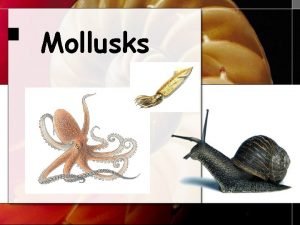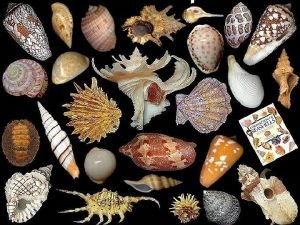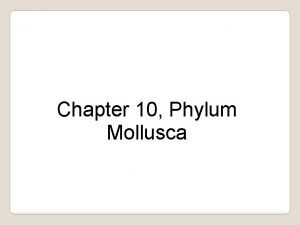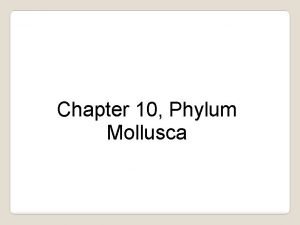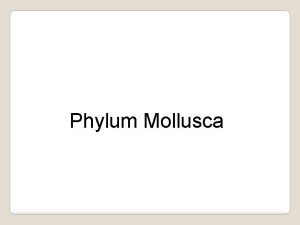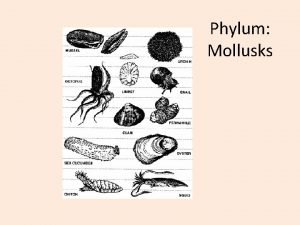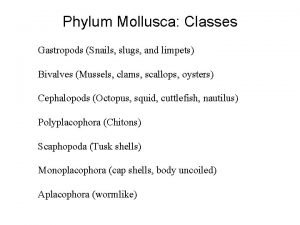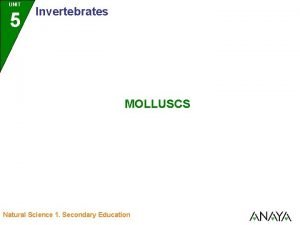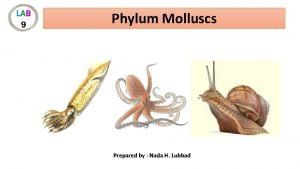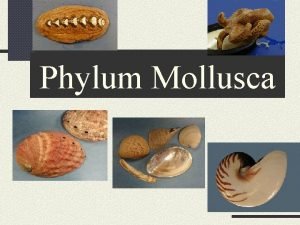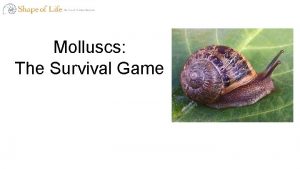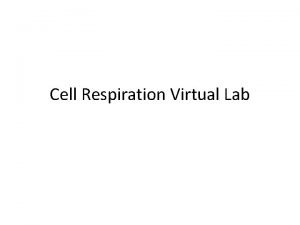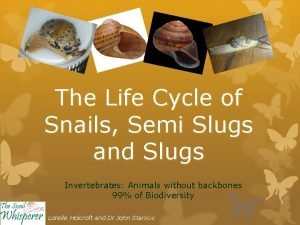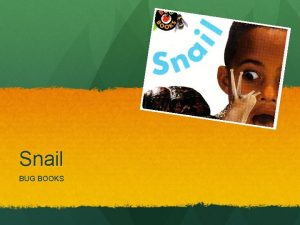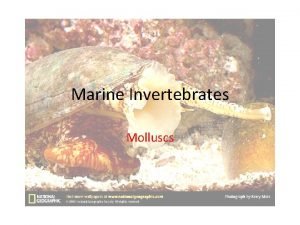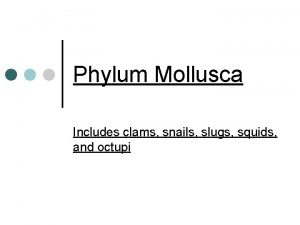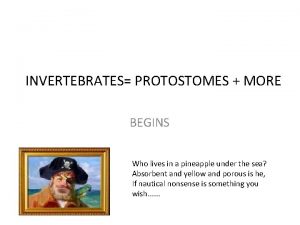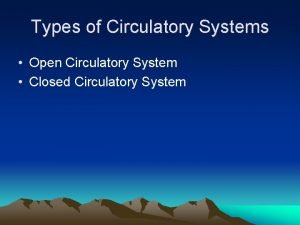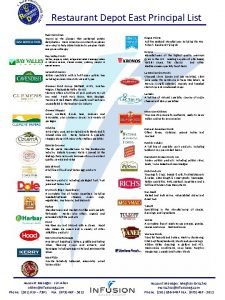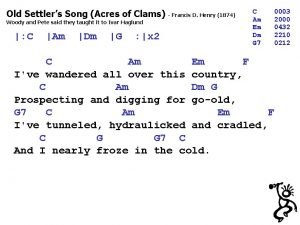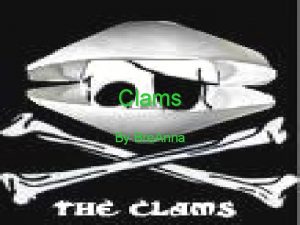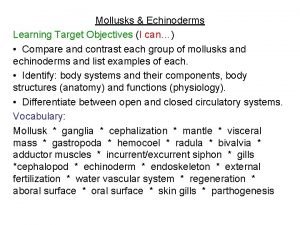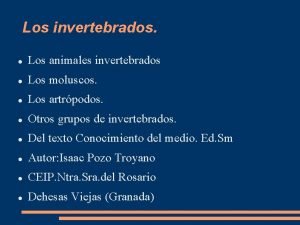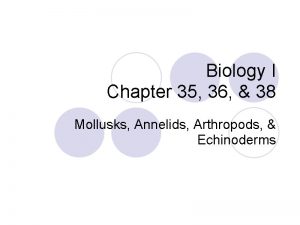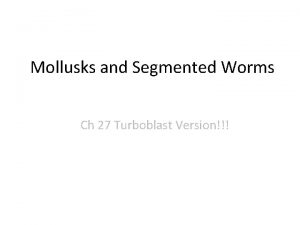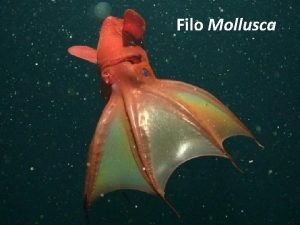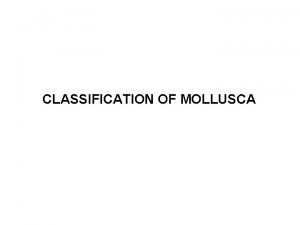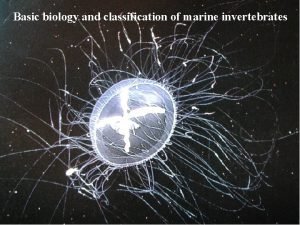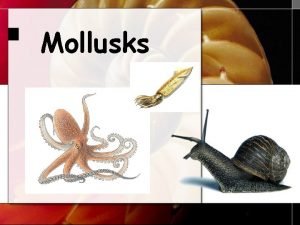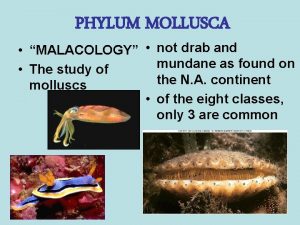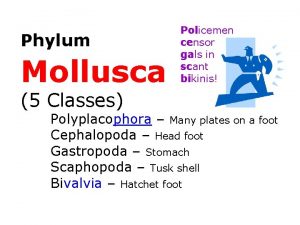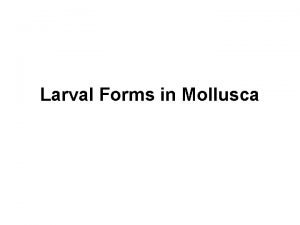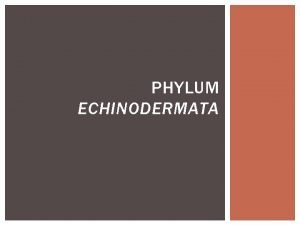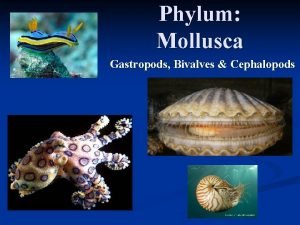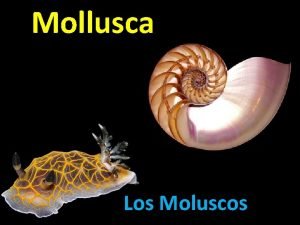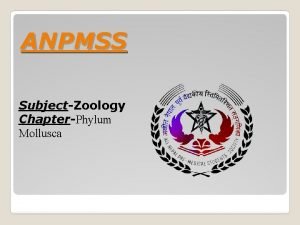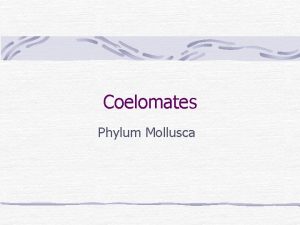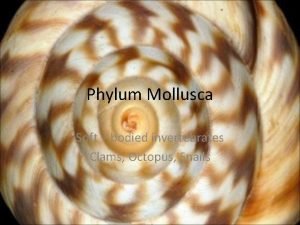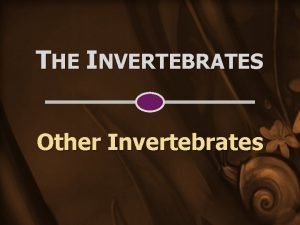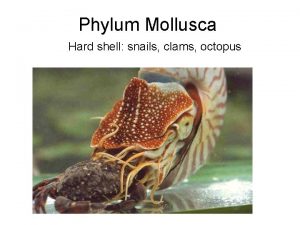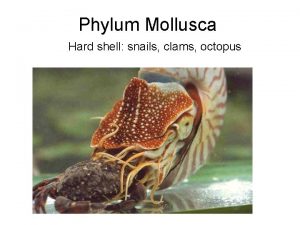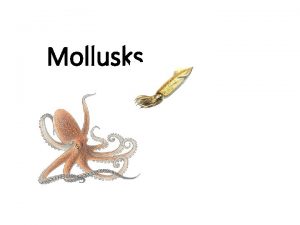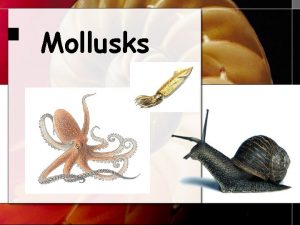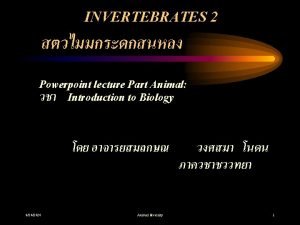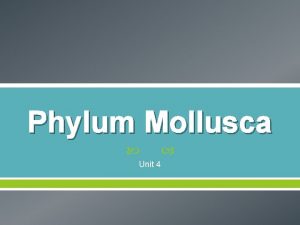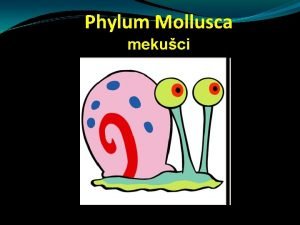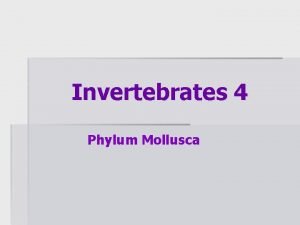Molluscs Phylum Mollusca l Includes snails clams octopuses














































- Slides: 46

Molluscs Phylum Mollusca

l Includes snails, clams, octopuses and others. l There are more species of molluscs in the ocean than any other animal group. l There are 200, 000 species of molluscs.

Mollusk Structure l Have soft bodies enclosed in a calcium carbonate shell. l Mantle- thin layer of tissue that secretes the shell. l Bilaterally symmetrical. l Ventral, muscular foot used for locomotion. l Head with eyes and other sensory organs.

l Radula- ribbon of small teeth used to feed by rasping food from surfaces. l Radula made of chitin. l Gills for gas exchange.


Types of Molluscs l They occupy all marine environments from the wave-splashed rocky shores to hydrothermal vents.

Gastropods (Class Gastropoda) l l l l Largest, most common, and most varied. Snails are most familiar. Also includes limpets, abalones, nudibranchs. 75, 000 species. Most are coiled mass of vital organs enclosed by a dorsal shell. Shell rests on a ventral creeping foot. Gastropod means “stomach foot. ”

Limpet

Abalones

Nudibranch

Nutrition l Most use radula to scrape algae from rocks, like periwinkles, limpets, and abalones. l Some like mud snails are deposit feeders on the bottom. l Whelks, oyster drills, and cone shells are carnivores that prey on clams, oysters, worms and small fish.

Whelks

Oyster Drill

Cone Shell

l The violet snail Janthina has a thin shell and produces a bubble raft out of mucous to float on surface and look for its prey. , l Sea hares Aplysia have smal, thin shells buried in tissue that graze on seaweeds.

Janthina floating

Aplysia

Bivalves (Class Bivalva) l Clams, Mussels, Oysters l Body is laterally compressed (flattened sideways) and enclosed in a shell with two parts or valves. l No head and no radula. l Folded and expanded gills used to obtain oxygen and filter small food particles. l Mantle lines the inner shell. l Strong muscles close the valves.

Clams l Use shovel-foot to burrow in sand mud. l Water is drawn in through a siphon (snorkel). l This allow them to get oxygen even when buried in the sand.

Geoduck Clam

Mussels-Secrete byssal threads that attach on rocks and other surfaces. Oysters-cement their shell to a hard surface. Pearl oysters- form pearls when the oyster secretes calcium carbonate to coat irritations in mantle

Green lipped mussel

Oyster with pearl

l Many bivalves bore in coral, rock, or wood. l Shipworms-fouling organisms that settle on to bottom of boats, pilings and cause these to deteriorate.

Shipworms

Cephalopods (Class Cephalopoda) l Predators that include octopuses, squid, cuttlefish. l Nearly all are agile swimmers. l Have complex nervous system and a small or no shell. l 650 marine species. l Cephalopod means “head-foot. ”

l The food is modified into arms and tentacles, usually with suckers used to capture prey. l Have large eyes on the side of head. l Octopuses- round body l Squids- elongated body l Protected by a thick and muscular mantle.

Squidward

l Have two or four gills on head and water enters and leaves through a siphon (funnel). l Swim by forcing water out of mantle cavity through the siphon. l Use jet propulsion with siphon to move in any direction.

Octopuses l Have eight long arms and lack a shell. l Common bottom dwellers. l Size varies from 5 cm (2 in) to 9 m (30 ft). l Efficient hunters of crabs, lobsters, and shrimps. l Bite prey with a beak-like jaw. Radulas rasp away flesh. l Secrete a paralyzing substance and some have a toxic bite.

l Make their homes in crevices, bottles, etc. l They distract predators by emitting a cloud of dark fluid produced in the ink sac.

Octopus

Squids l Better swimmers than octopuses. l Elongated body covered with mantle has two triangular fins. l Use jet propulsion and can move forward and backward. l Eight arms and two tentacles with suckers around a mouth. l Shell reduced to a pen on upper mantle.

l Size varies from few centimeters to largest living invertebrate 60 ft!


Cuttlefish l Have eight arms and two tentacles. l Flat bodies and fin on the sides. l Have calcified internal shell that aids in buoyancy. l Shell called cuttlebone. l Cuttlebone sold as a source of calcium for cage birds.

Cuttlefish

Chambered Nautilus l Coiled, external shell with gas-filled chambers that serve for buoyancy. l Body in the outer chamber has 60 -90 short suckerless tentacles to capture prey.

Chambered Nautilus

Chitons (Class Polyplacophora) l 800 species l Have 8 overlapping shell plates on dorsal surface. l Internal organs not coiled. l Live on shallow, hard bottoms using radula to feed on algae.

Chiton

Scaphopds (Class Scaphopoda) l Tusk shells. l Elongated shell open at top and tapered elephant-like tusk l Live on sand or muddy bottoms. l Have thin tentacles with adhesive strips to capture foraminiferans.

Tusk Shells

Feeding and Digestion l Use salivary and digestive glands that release enzymes to break down food. l Bivalves have crystalline style that secretes enzymes in the stomach. l Have open circulatory system where blood flows out of vessels and into the body cavity. l Cephalopods have closed circulation.

Nervous System and Behavior l Gastropods and bivalves have gangliaclusters of nerve cells. l Octopuses have a brain that allow for learning. l When preyed upon some release ink and can change color.

Reproduction and Life History l Most have separate sexes. l Some are hermaphrodites. l Bivalves release sperm and eggs in the water. l Cephalopods mate and use a spermatophore (modified arm) to transfer a packet of sperm. l Males have a long, flexible penis.
 Bivalves
Bivalves Muluska
Muluska Mollusca open circulatory system
Mollusca open circulatory system Mollusca
Mollusca Phylum mollusca homework and study guide #1
Phylum mollusca homework and study guide #1 Monoplacophora characteristics
Monoplacophora characteristics Mollusca characteristics
Mollusca characteristics 3 groups of mollusks
3 groups of mollusks Embryophagous
Embryophagous Molluscs
Molluscs Phylum
Phylum Gastropoda
Gastropoda How does the cockle avoid the moon snail?
How does the cockle avoid the moon snail? Snails and elodea virtual lab
Snails and elodea virtual lab Snails life cycle
Snails life cycle Are snails bugs
Are snails bugs Do snails have legs
Do snails have legs Are owls carnivores herbivores or omnivores
Are owls carnivores herbivores or omnivores Invertebrates including snails slugs and mussels
Invertebrates including snails slugs and mussels Invertebrates including snails slugs and mussels
Invertebrates including snails slugs and mussels Are snails coelomates pseudocoelomates or acoelomates
Are snails coelomates pseudocoelomates or acoelomates Are slices cut horizontally from a large fish
Are slices cut horizontally from a large fish Do clams have open or closed circulatory systems
Do clams have open or closed circulatory systems Cat/clams scoring sheet
Cat/clams scoring sheet Restaurant depot clams
Restaurant depot clams Old settlers song
Old settlers song Razor clam life cycle
Razor clam life cycle What do clams look like inside
What do clams look like inside Moluscos son invertebrados
Moluscos son invertebrados Oligocheta
Oligocheta Mollusks segmentation
Mollusks segmentation Filo mollusca
Filo mollusca Sepia
Sepia Symmetry in mollusca
Symmetry in mollusca Mollusca subphylum
Mollusca subphylum Oysters phylum
Oysters phylum Mollusca
Mollusca Umbo mollusca
Umbo mollusca Charneira moluscos
Charneira moluscos Trochophore phylum
Trochophore phylum Echinodermata
Echinodermata Conch phylum
Conch phylum Polyplacophora
Polyplacophora Brachiozoa
Brachiozoa Nbilateral
Nbilateral Moluscos
Moluscos Parasite classification
Parasite classification
